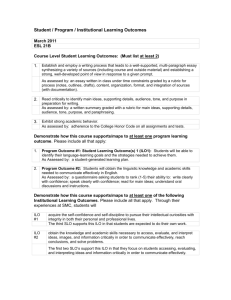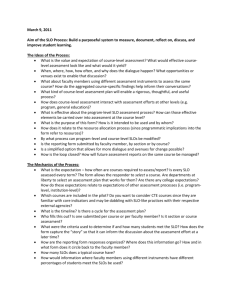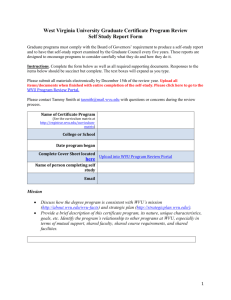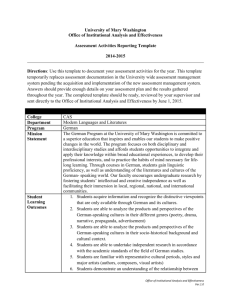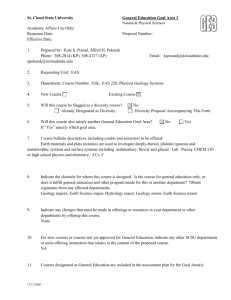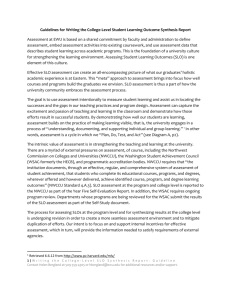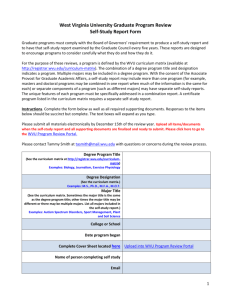Assessment - Central Washington University
advertisement
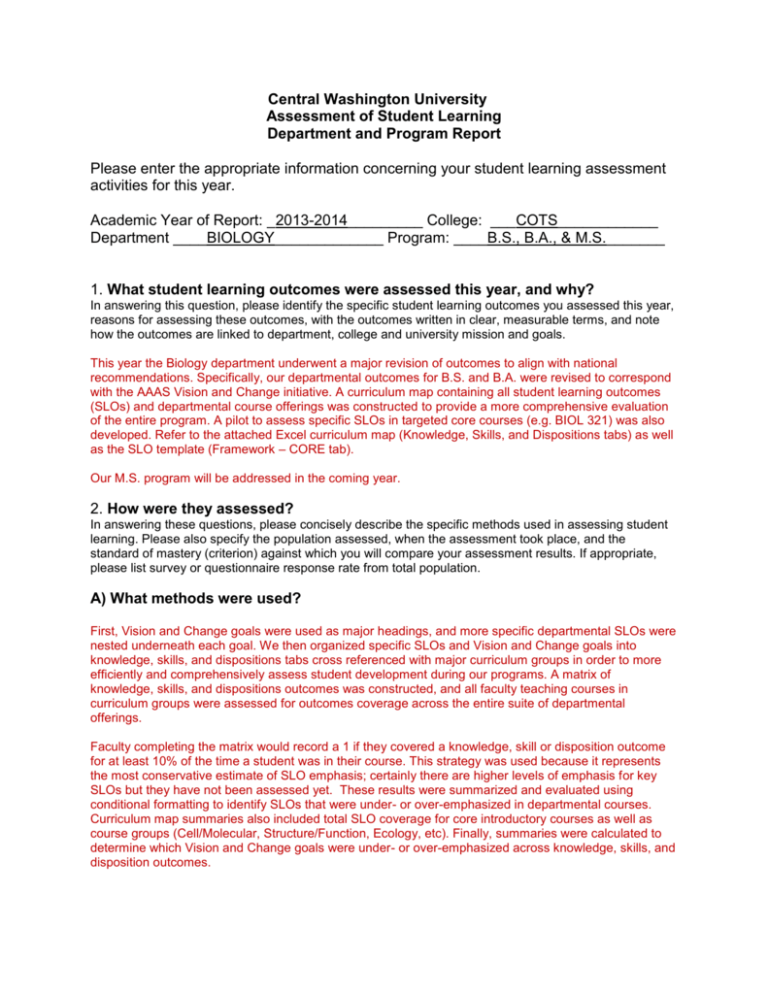
Central Washington University Assessment of Student Learning Department and Program Report Please enter the appropriate information concerning your student learning assessment activities for this year. Academic Year of Report: _2013-2014_________ College: ___COTS____________ Department ____BIOLOGY_____________ Program: ____B.S., B.A., & M.S._______ 1. What student learning outcomes were assessed this year, and why? In answering this question, please identify the specific student learning outcomes you assessed this year, reasons for assessing these outcomes, with the outcomes written in clear, measurable terms, and note how the outcomes are linked to department, college and university mission and goals. This year the Biology department underwent a major revision of outcomes to align with national recommendations. Specifically, our departmental outcomes for B.S. and B.A. were revised to correspond with the AAAS Vision and Change initiative. A curriculum map containing all student learning outcomes (SLOs) and departmental course offerings was constructed to provide a more comprehensive evaluation of the entire program. A pilot to assess specific SLOs in targeted core courses (e.g. BIOL 321) was also developed. Refer to the attached Excel curriculum map (Knowledge, Skills, and Dispositions tabs) as well as the SLO template (Framework – CORE tab). Our M.S. program will be addressed in the coming year. 2. How were they assessed? In answering these questions, please concisely describe the specific methods used in assessing student learning. Please also specify the population assessed, when the assessment took place, and the standard of mastery (criterion) against which you will compare your assessment results. If appropriate, please list survey or questionnaire response rate from total population. A) What methods were used? First, Vision and Change goals were used as major headings, and more specific departmental SLOs were nested underneath each goal. We then organized specific SLOs and Vision and Change goals into knowledge, skills, and dispositions tabs cross referenced with major curriculum groups in order to more efficiently and comprehensively assess student development during our programs. A matrix of knowledge, skills, and dispositions outcomes was constructed, and all faculty teaching courses in curriculum groups were assessed for outcomes coverage across the entire suite of departmental offerings. Faculty completing the matrix would record a 1 if they covered a knowledge, skill or disposition outcome for at least 10% of the time a student was in their course. This strategy was used because it represents the most conservative estimate of SLO emphasis; certainly there are higher levels of emphasis for key SLOs but they have not been assessed yet. These results were summarized and evaluated using conditional formatting to identify SLOs that were under- or over-emphasized in departmental courses. Curriculum map summaries also included total SLO coverage for core introductory courses as well as course groups (Cell/Molecular, Structure/Function, Ecology, etc). Finally, summaries were calculated to determine which Vision and Change goals were under- or over-emphasized across knowledge, skills, and disposition outcomes. Second, a vertical alignment structure was developed to assess SLO performance according to major content themes in courses. For example, the structure used to assess student mastery of the concept of meiosis would begin in core introductory courses using indicator questions embedded in content exams appropriate at that level (level 1). More difficult questions (level 2 or 3) would assess the same concept of meiosis in higher level courses. This system will help ensure student development is proceeding as planned and that students are developing their knowledge in accordance with research-supported best practices. A pilot was developed in BIOL 321 due to the close collaboration of the 3 faculty teaching that course. Similar structures were developed by faculty working groups for other content areas (e.g. Evolution, Ecology, Cell/Molecular Biology, Structure/Function, etc. A similar approach will be used for our master’s program, though we have not yet begun this work. B) Who was assessed? Nearly all courses in the Department of Biological Sciences were assessed for the curriculum map (see attached curriculum map with Knowledge, Skills, and Dispositions tabs). BIOL 321 was assessed to pilot the vertical alignment structure (see Framework – CORE tab for an example). C) When was it assessed? Vision and Change and SLOs were assessed during the 2014-2015 academic year. 3. What was learned? In answering this question, please report results in specific qualitative or quantitative terms, with the results linked to the outcomes you assessed, and compared to the standard of mastery (criterion) you noted above. Please also include a concise interpretation or analysis of the results. First, our new assessment and evaluation structure works well. We now have a clear idea of what courses contribute most to specific student knowledge, skills, and dispositions. For a Knowledge example, 23 courses “relate physical structure to biological function across all levels of organization” (SLO K1.1), whereas 6 courses “compare structures and processes of prokaryotic and eukaryotic cells” (SLO K1.4). For a Skills example, 28 courses “draw appropriate inferences and generalizations from data” (SLO S1.9), while 3 courses “construct scientifically accurate models using manipulatives or software” (SLO S2.4). For a Dispositions example, 18 courses “apply scientific methods and principles to biological problems” (SLO D5.1), while 2 courses “balance conventional approaches with new ways of solving problems”(SLO D3.3). Second, we now know which Vision and Change national goals our department performs well on, and which need further adjustment. For Knowledge, learning experiences emphasize student understanding of structure and function relationships (N=106 course instances) than any other national goal (V and C K1). Learning experiences emphasize less (N=42 course instances) on student understanding of pathways and transformation of energy and matter (V and C K2). For Skills, learning experiences emphasize more (N=162 course instances) on student ability to apply the processes of science (V and C S1), and less (N=25 course instances) on student ability to understand the relationship between science and society (N=25 course instances). For Dispositions, learning experiences most emphasize (N=60) student development of scholarly behaviors (D1), and least emphasize (N=9 course instances) integrity and ethical behavior (D6). 4. What will the department or program do as a result of that information? In answering this question, please note specific changes to your program as they affect student learning, and as they are related to results from the assessment process. If no changes are planned, please describe why no changes are needed. In addition, how will the department report the results and changes to internal and external constituents (e.g., advisory groups, newsletters, forums, etc.). Planning is already underway based on our assessment results. The first step in our multi-year plan was to become more aware of areas of emphasis for student learning and achievement of departmental and national goals. We have achieved that short-term goal. Moving forward, our goal will be – as it has always been – to improve our courses and curriculum to the extent possible, given current resource and other limitations. Our curriculum map provides the level of resolution needed to make the most informed, databased decisions that are in the best interests of students and departmental faculty and staff. Current and future curriculum decisions, both at the course and program levels, can now be made based on information derived from our assessment data and map and help ensure a refined and maximally effective learning experience for all. 5. What did the department or program do in response to last year’s assessment information? In answering this question, please describe any changes that have been made to improve student learning based on previous assessment results. Please also discuss any changes you have made to your assessment plan or assessment methods. Our assessment system was completely revised based on national best practices, national goals, and a collective desire to provide the best possible education for Biology students. Our faculty have worked collaboratively to revise courses and amend curriculum. We are a strong department that will become stronger as a result of these assessment results. 6. Questions or suggestions concerning Assessment of Student Learning at Central Washington University:


